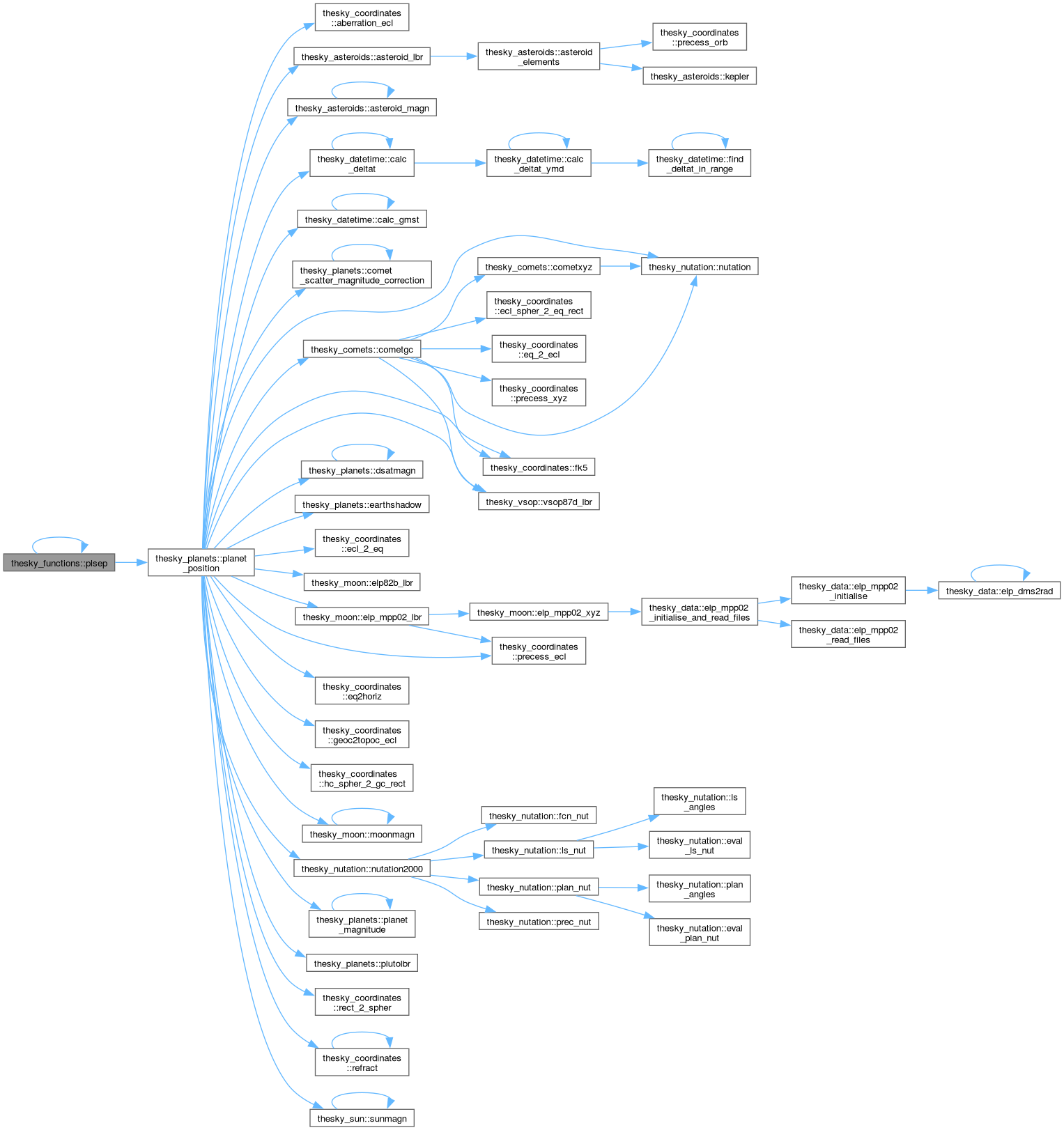 |
libTheSky
Routines to compute sky positions of Sun, Moon, planets and more
|
 |
libTheSky
Routines to compute sky positions of Sun, Moon, planets and more
|
Assorted procedures. More...
Functions/Subroutines | |
| subroutine | set_thesky_location (lat0, lon0, height, tz0, dsttp) |
| Set a location, using the variables in TheSky_local. | |
| integer function | const_id (jd, ra, dec) |
| Identify the constellation a,d lies in. | |
| real(double) function | plsep (jd0, p1, p2) |
| Calculates the angular separation between two planets. | |
| real(double) function | plpa (jd0, p1, p2) |
| Calculates the position angle of planet 2 with respect to planet 1, COUNTERCLOCKWISE from the north. | |
| subroutine | conabr2conid (myconabr, myconid) |
| Convert a three-letter constellation abbreviation to a constellation ID number. | |
| character function, dimension(99) | fillfloat (x, tot, dgt) |
| Print a floating-point number with leading zeros in format (0...0)Ftot.dgt to a string. | |
| character function, dimension(11) | ds (d) |
| Print planet distance in AU as a nice string, but use km for the Moon. | |
| character function, dimension(9) | ds1 (d) |
| Print planet distance in AU as a nice string, but use km for the Moon - smaller string. | |
Assorted procedures.
| subroutine thesky_functions::conabr2conid | ( | character, dimension(*), intent(in) | myconabr, |
| integer, intent(out) | myconid ) |
Convert a three-letter constellation abbreviation to a constellation ID number.
| myconabr | Constellation abbreviation (e.g. And) |
| myconid | Constellation ID number (output) |
Definition at line 227 of file functions.f90.
References thesky_stardata::conabr, and thesky_stardata::nconstel.
| integer function thesky_functions::const_id | ( | real(double), intent(in) | jd, |
| real(double), intent(in) | ra, | ||
| real(double), intent(in) | dec ) |
Identify the constellation a,d lies in.
| jd | Equinox in JD |
| ra | RA in radians |
| dec | Dec in radians |
| const_id | The constellation ID |
Definition at line 83 of file functions.f90.
References thesky_stardata::conid, thesky_stardata::coniddecl, thesky_stardata::conidral, thesky_stardata::conidrau, const_id(), and thesky_coordinates::precess_eq().
Referenced by const_id().

| character function, dimension(11) thesky_functions::ds | ( | real(double), intent(in) | d | ) |
Print planet distance in AU as a nice string, but use km for the Moon.
| d | Distance (AU) |
| ds | String containing the formatted distance in AU |
Definition at line 285 of file functions.f90.
References ds().
Referenced by ds().

| character function, dimension(9) thesky_functions::ds1 | ( | real(double), intent(in) | d | ) |
Print planet distance in AU as a nice string, but use km for the Moon - smaller string.
| d | Distance (AU) |
| ds1 | String containing the formatted distance in AU |
Definition at line 306 of file functions.f90.
References ds1().
Referenced by ds1().

| character function, dimension(99) thesky_functions::fillfloat | ( | real(double), intent(in) | x, |
| integer, intent(in) | tot, | ||
| integer, intent(in) | dgt ) |
Print a floating-point number with leading zeros in format (0...0)Ftot.dgt to a string.
| x | Number to be printed |
| tot | Total length of printed number - Ftot.dgt |
| dgt | Number of decimal digits - Ftot.dgt |
| fillfloat | String containing the float with leading zeros. |
Definition at line 257 of file functions.f90.
References fillfloat().
Referenced by fillfloat().

| real(double) function thesky_functions::plpa | ( | real(double), intent(in) | jd0, |
| integer, intent(in) | p1, | ||
| integer, intent(in) | p2 ) |
Calculates the position angle of planet 2 with respect to planet 1, COUNTERCLOCKWISE from the north.
| jd0 | Julian day for calculation |
| p1 | ID of planet 1 |
| p2 | ID of planet 2 |
| plpa | The position angle of planet 2 with respect to planet 1, COUNTERCLOCKWISE from the north (rad) |
Definition at line 192 of file functions.f90.
References thesky_planets::planet_position(), thesky_planetdata::planpos, and plpa().
Referenced by plpa().

| real(double) function thesky_functions::plsep | ( | real(double), intent(in) | jd0, |
| integer, intent(in) | p1, | ||
| integer, intent(in) | p2 ) |
Calculates the angular separation between two planets.
| jd0 | Julian day for calculation |
| p1 | ID of planet 1 |
| p2 | ID of planet 2 |
| plsep | The angular separation between the two planets (rad) |
Definition at line 152 of file functions.f90.
References thesky_planets::planet_position(), thesky_planetdata::planpos, and plsep().
Referenced by plsep().

| subroutine thesky_functions::set_thesky_location | ( | real(double), intent(in) | lat0, |
| real(double), intent(in) | lon0, | ||
| real(double), intent(in) | height, | ||
| real(double), intent(in) | tz0, | ||
| integer, intent(in) | dsttp ) |
Set a location, using the variables in TheSky_local.
| lat0 | Latitude (radians, >0 is northern hemisphere) |
| lon0 | Longitude (radians, >0 is east of Greenwich) |
| height | Altitude/elevation above sealevel, in metres |
| tz0 | Default timezone (standard time, no DST, >0 is east of Greenwich) |
| dsttp | DST type: 0-none, 1-EU, 2-USA |
Definition at line 53 of file functions.f90.
References thesky_local::dsttp, thesky_local::height, thesky_local::lat0, thesky_local::lon0, thesky_local::tz, and thesky_local::tz0.